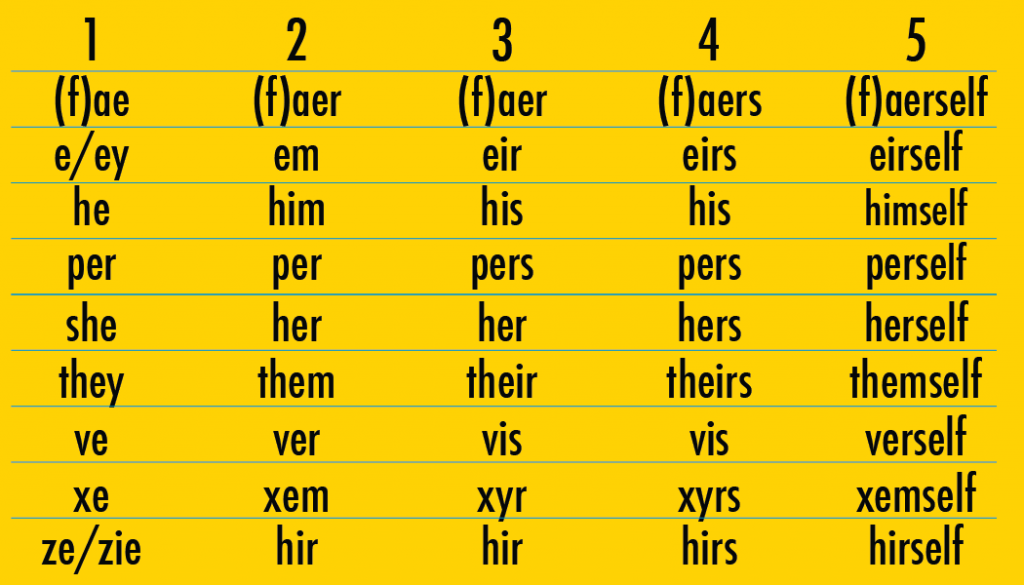Inclusion nowadays has turned into an important matter to realize. The non-binary and Transgender community has risen up in order to be heard. As with every change in society, gets involved in not only the behave but also in the communicative language and interaction. Many Colleges have committed to valuing and validating the gender identity and expression of members of their campus community. This has been done is by encouraging all members of their campus community to indicate the pronouns they use for themselves, if desired, in classes, workplaces, and other settings, and by encouraging members of the campus community to respect these pronouns.
In order to get a better idea about this topic, it is important to know what we are talking about.
What is a pronuoun?
- A pronoun is a word that is used instead of a noun or a noun phrase to refer to individuals.
- Pronouns can be in the first person singular (I, me) or plural (we, us); second person singular or plural (you); and the third person singular (e.g., she/her, he/him, they/them, ze/hir) or plural (they/them).
- Gendered pronouns specifically reference someone’s gender: he/him/his or she/her/hers.
The traditional pronouns in English Grammar are:

Non-binary and Transgender Pronouns
While many trans people identify on a binary scale, either as male or female, some do not and may instead refer to themselves as “gender fluid,” “non-binary,” or other terms. Non-binary people, those who do not identify themselves as male or female, may choose to use gender pronouns such as “Ze (“zee”)” instead of the gender “he or they” or “she and them”.
Using the right personal pronouns is a way to respect them and create an inclusive environment, just as using a person’s name can be a way to respect them. Just as it can be offensive or challenging to invent a nickname for someone and call it that against their will, it can be offensive or challenging to guess someone’s pronouns and refer to them using those pronouns if that’s not how that person wants to be known. Or worse, choosing to ignore the pronouns someone has said they use could involve ignoring the notion that intersex, transgender, non-binary, non-gender-conforming people exist or assuming they shouldn’t exist. Language-like identities are constantly evolving.
Here is a list of the most common Gender Personal Pronouns used:
The image lists eight pronouns, from “ey” to “zie,” and illustrates how they change depending on their role in a sentence. Instead of “he/she,” “him/her,” “his/her,” “his/hers,” and “himself/herself” it would be:
- “ey,” “em,” “eir,” “eirs,” and “eirself”, or
- “zie,” “zim,” “zir,” “zirs,” and “zirself”
There are many different gender pronouns, but here are the most common used :
Most commonly Non-binary and Transgender pronouns used.
| Pronoun | Sounds like | Variations |
|---|---|---|
| He/Him | You already know this one! | His, Himself |
| She/Her | You already know this one! | Hers, Herself |
| They/Them | Yes, it’s okay to use this referring to a singular person! | Theirs, themself |
| Ze (or Zie) | Zee (like “see” with a “Z”). | Can also be spelled as xe |
| Name | Whatever their name is! | Some people don’t want to use pronouns at all and will ask you to refer to them by their name alone. |
Some languages, such as English, do not have a gender-neutral or third gender pronoun available, and this has been criticized, since, in many instances, writers, speakers, etc. use “he/his” when referring to a generic individual in the third person. Also, the dichotomy of “he and she” in English does not leave room for other gender identities, which is a source of frustration to the transgender and genderqueer communities.
Whatever is the case, you must show respect and try to aware of what other people feel like. It doesn’t matter wheater they are aliens, human beings, animals, or energy elements, we all need respect. In case of messing up in not knowing what to do in a situation of miss-used gender pronouns, here is a quick guide that might help:
Glossary
- Transgender: Applies to a person whose gender is different from their “assigned” sex at birth
- Cisgender: Applies to someone whose gender matches their “assigned” sex at birth (ie someone who is not transgender)
- Non-binary: Applies to a person who does not identify as “male” or “female”
- Genderqueer: Similar to “non-binary” – some people regard “queer” as offensive, others embrace it
- Genderfluid: Applies to a person whose gender identity changes over time
For more information you can visit the next sites:
- https://www.bbc.com/news/magazine-34901704
- https://lgbtlifecenter.org/pronouns/
- https://springfield.edu/gender-pronouns
To keep up with fresh updates, read our latest posts in Blog EHLI
